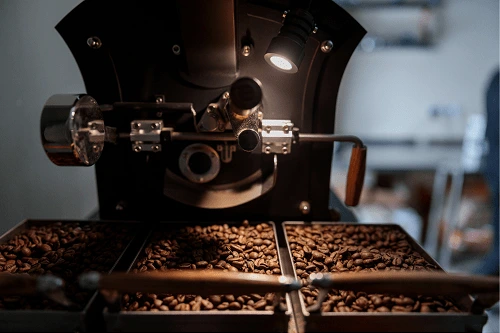Coffee
How to Start a Coffee Roastery
Are you passionate about coffee and interested in starting your own coffee roastery? Roasting coffee beans is an art that requires skill, knowledge, and dedication. In this article, we will guide you through the process of starting a coffee roastery, from sourcing high-quality beans to establishing your brand and attracting customers. So grab a cup of your favorite brew and let’s dive in!
Starting a coffee roastery can be an exciting and rewarding venture for coffee enthusiasts. By controlling the entire roasting process, you can craft unique flavors and establish your brand in the competitive coffee market. However, it’s essential to understand the various aspects involved and follow a systematic approach. This guide will provide you with the necessary steps to get started on your coffee roasting journey.
2. Understanding the Coffee Roasting Process
Before diving into the specifics of starting a coffee roastery, it’s crucial to have a solid understanding of the coffee roasting process. This process involves transforming green coffee beans into aromatic and flavorful roasted beans. Let’s explore the key elements of this process.
2.1 Green Coffee Beans
The foundation of great coffee starts with high-quality green coffee beans. These beans are sourced from coffee-growing regions worldwide. Factors such as origin, altitude, processing methods, and varietals contribute to the unique characteristics of the beans. As a coffee roaster, you’ll have the opportunity to select beans that align with your desired flavor profiles and sourcing values.
2.2 Roasting Techniques
Roasting techniques play a crucial role in developing the flavors of coffee beans. Different roast levels, such as light, medium, and dark, result in distinct taste profiles. Each roast level brings out different flavor notes and aromas. Experimentation and experience will help you refine your roasting techniques and create exceptional coffees.
2.3 Roasting Equipment
Investing in suitable roasting equipment is vital for a successful coffee roastery. There are various types of roasting machines available, ranging from small batch roasters to larger production roasters. Consider your production capacity, budget, and desired level of automation when choosing the right roasting equipment for your business.
3. Sourcing High-Quality Coffee Beans
The quality of your coffee beans has a significant impact on the final product. Here are some key considerations when sourcing your beans:
3.1 Direct Trade vs. Wholesale
Decide whether you want to source your beans directly from coffee farmers or through wholesalers. Direct trade allows you to establish personal relationships with farmers, ensuring transparency and fair prices. On the other hand, wholesale suppliers offer convenience and a broader selection of beans.
3.2 Establishing Relationships with Coffee Farmers
If you choose to pursue direct trade, it’s important to build relationships with coffee farmers. Visit coffee-producing regions, attend trade shows, and network with industry professionals to connect with farmers. Building trust and understanding their cultivation practices will help you source high-quality beans consistently.
3.3 Evaluating Bean Quality
Developing a discerning palate and understanding coffee bean quality is crucial for a coffee roaster. Assess factors like bean size, color, aroma, moisture content, and defects. Cupping sessions, where you evaluate the taste and aroma of brewed coffee, can help you determine the quality of the beans.
4. Setting Up Your Coffee Roastery
Establishing a suitable space for your coffee roastery is essential for efficient operations. Consider the following factors:
4.1 Finding the Right Location
Look for a location that offers sufficient space for your roasting equipment, storage, and potential expansion. Ensure the space meets safety and ventilation requirements, as roasting generates smoke and fumes. Consider proximity to transportation routes for easy logistics.
4.2 Roasting Equipment and Setup
Invest in quality roasting equipment that suits your production scale. Install necessary utilities like gas or electricity connections, ventilation systems, and fire safety measures. Arrange your workspace for a smooth workflow, keeping in mind the storage of green and roasted beans.
4.3 Ensuring Safety and Compliance
Adhere to safety regulations and obtain necessary permits and licenses. Implement proper fire safety measures and follow guidelines for handling, storing, and disposing of coffee beans. Consider insurance coverage to protect your business from unforeseen circumstances.
5. Developing Your Coffee Roasting Profiles
Creating unique flavor profiles is an exciting aspect of coffee roasting. Here’s how you can develop your roasting profiles:
5.1 Experimenting with Roasting Levels
Explore different roast levels to understand their impact on flavor. Start with small batches and adjust variables like time and temperature to achieve desired results. Document your experiments to build a repertoire of roast profiles.
5.2 Creating Unique Flavor Profiles
Roasting is a delicate balance of time, temperature, and technique. Develop your signature flavor profiles by tweaking the roast parameters. Consider factors like acidity, body, sweetness, and aroma to create coffees that stand out.
5.3 Documenting and Fine-tuning
Maintain detailed records of each roast, including the green beans used, roast profiles, and tasting notes. This documentation will help you replicate successful roasts and refine your techniques over time. Regular cupping sessions will allow you to evaluate the flavor development and make necessary adjustments.
6. Establishing Your Brand
Building a strong brand identity will differentiate your coffee roastery from the competition. Focus on the following aspects:
6.1 Defining Your Vision and Values
Determine your unique selling proposition and the values you want your brand to represent. Craft a compelling brand story that resonates with your target audience. Whether it’s sustainability, fair trade, or supporting local communities, align your brand with meaningful values.
6.2 Creating a Memorable Brand Identity
Design a visually appealing logo, choose a color palette, and create cohesive brand imagery. Ensure your brand elements reflect the essence of your coffee and resonate with your target market. Consistency in branding across packaging, website, and social media will help create brand recognition.
6.3 Packaging and Labeling
Invest in attractive and informative packaging for your roasted beans. Consider sustainable materials and include relevant details such as roast date, flavor notes, and brewing recommendations. Well-designed packaging enhances the overall customer experience and builds brand loyalty.
7. Marketing and Promoting Your Coffee Roastery
To attract customers and grow your business, effective marketing strategies are crucial. Consider the following approaches:
7.1 Building an Online Presence
Create a professional website that showcases your brand, products, and brewing methods. Optimize your website for search engines to improve online visibility. Engage with customers through a blog, social media platforms, and email newsletters.
7.2 Social Media Marketing
Utilize social media platforms like Instagram, Facebook, and Twitter to share engaging content. Post high-quality photos, videos, and educational posts about coffee. Encourage user-generated content and interact with your audience to build a community around your brand.
7.3 Collaborations and Partnerships
Collaborate with local cafes, restaurants, and businesses that share your values. Offer to supply them with your specialty coffee and explore joint marketing initiatives. Participate in coffee events and festivals to showcase your brand to a wider audience.
8. Building Relationships with Wholesale Clients
Wholesale partnerships can significantly contribute to the growth of your coffee roastery. Focus on the following strategies:
8.1 Identifying Potential Wholesale Customers
Research and target local cafes, restaurants, hotels, and offices that align with your brand values. Attend industry trade shows and networking events to connect with potential wholesale clients. Tailor your offerings to meet their specific needs and preferences.
8.2 Offering Customization and Support
Provide customized coffee blends or exclusive roast profiles for your wholesale clients. Offer training sessions and ongoing support to their staff, ensuring they can serve your coffee with confidence. Build strong relationships based on trust, quality, and excellent customer service.
8.3 Providing Consistent Quality and Service
Consistency is key to retaining wholesale clients. Ensure your roasted beans are of consistent quality and flavor. Streamline your order fulfillment process, maintain open communication, and promptly address any issues that arise. Continuously seek feedback to improve your products and services.
9. Opening Your Coffee Roastery Café
Expanding your business to include a roastery café can be a great way to showcase your coffee and engage with customers. Consider the following aspects:
9.1 Designing a Welcoming Space
Create an inviting atmosphere that reflects your brand identity. Choose comfortable seating, design an aesthetically pleasing interior, and incorporate elements that highlight the coffee roasting process. Consider offering coffee tastings and tours to educate customers about your craft.
9.2 Creating a Menu
Develop a menu that showcases your coffee offerings alongside complementary food options. Consider collaborating with local bakeries or chefs to provide unique and delicious pairings. Cater to different preferences, such as espresso-based drinks, pour-over options, and alternative milk choices.
9.3 Hiring and Training Staff
Select knowledgeable and passionate staff who can effectively communicate your brand story and engage with customers. Provide comprehensive training on coffee brewing techniques, customer service, and brand values. Encourage staff to be brand ambassadors and consistently deliver exceptional experiences.
10. Conclusion
Starting a coffee roastery is a journey that combines passion, skill, and business acumen. By following the steps outlined in this article, you can lay a strong foundation for your roastery and set yourself up for success. Remember to prioritize sourcing high-quality beans, develop unique roast profiles, build a strong brand, and market your products effectively. With dedication and perseverance, you can establish a thriving coffee roastery that delights coffee lovers and leaves a lasting impact in the industry.
FAQs (Frequently Asked Questions)
1 How much does it cost to start a coffee roastery?
The cost of starting a coffee roastery can vary depending on several factors, including the scale of operations, equipment choices, and location. On average, you can expect to invest anywhere from ₹5,00000 to ₹30,00000 or more. It’s important to create a detailed business plan and budget to estimate the costs accurately.
2 How long does it take to roast coffee beans?
The duration of coffee bean roasting depends on factors such as the desired roast level, bean type, and roasting equipment used. Generally, roasting can take anywhere from 10 to 20 minutes. However, it’s essential to monitor the process closely to achieve the desired flavor and aroma.
3 Do I need any specific certifications to start a coffee roastery?
Yes, FSSAI (Food Safety and Standards Authority of India) license is required to start a coffee roastery, and other certifications are not mandatory, but they can enhance your credibility and provide assurance to customers. Consider pursuing certifications such as Fair Trade, Organic, or Rainforest Alliance if they align with your sourcing and sustainability goals.
4 What is the shelf life of roasted coffee beans?
Roasted coffee beans are at their best within two to four weeks after the roast date. During this period, the beans retain their freshness and optimal flavor. However, they can still be enjoyed for several months, although the flavors may gradually diminish over time.
5 Can I roast coffee beans at home?
Yes, it is possible to roast coffee beans at home using specialized home roasting machines or even with simple methods like using a popcorn popper or an oven. Home roasting allows you to experiment with different beans and roast levels, providing a unique coffee experience. However, be cautious and follow safety guidelines while roasting at home.

